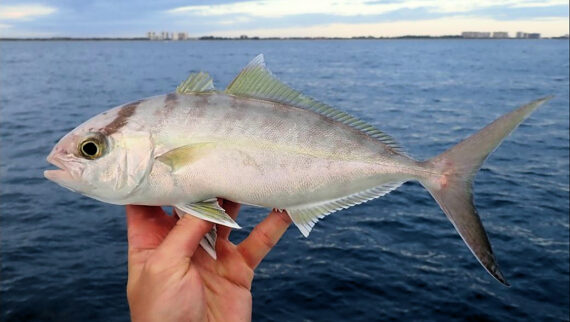Lesser Amberjack, Seriola fasciata
 Lesser Amberjack, Seriola fasciata. Fish caught from coastal waters off Deerfield Beach, Florida, December 2020. Length: 32 cm (13 inches). Catch and photograph courtesy of Ben Cantrell, San Diego, California.
Lesser Amberjack, Seriola fasciata. Fish caught from coastal waters off Deerfield Beach, Florida, December 2020. Length: 32 cm (13 inches). Catch and photograph courtesy of Ben Cantrell, San Diego, California.
The Lesser Amberjack, Seriola fasciata, is a member of the Jack or Carangidae Family, that is also known as the False Amberjack and the Little Amberjack and in Mexico as medregal listado. There are nine global members of the genus Seriola, of which six are found in Mexican waters, three in the Atlantic, and three in the Pacific Ocean.
The Lesser Amberjack has a “jack-like” elongated fusiform compressed fusiform body. They are olive-green or blackish brown in color with silvery flanks with a prominent dark stripe that runs from behind the eye and stops well short of the first dorsal fin. Most have a yellow stripe that runs from the eye along the flank to the caudal base. Their anal fins are dark with white lobes; their caudal fin is dark with a lighter band near the margin; and, their pelvic fins are white with dark inner parts. The juveniles have an oblique head band and seven irregular broken dark bars on their side with the last five extending into the anal and dorsal fins. Their head has a long, pointed snout, modest sized eyes, and a large terminal mouth equipped with minute teeth. Their anal fin has 2 spines followed by 1 spine and 17 to 20 rays and is about two-thirds the length of the second dorsal fin and has low lobes; their caudal fin has a slender base and is strongly forked; their first dorsal fin has 9 spines; and, their second dorsal fin has 1 spine and 28 to 33 rays and has low lobes. They have 23 to 26 gill rakers. Their lateral line has a slight arch over the pectoral fin region.
The Lesser Amberjack are found over deep-water reefs at depths between 20 m (66 feet) and 348 m (1,140 feet). They reach a maximum of 79 cm (2 feet 7 inches) in length and 4.6 kg (10 lbs 1 oz) in weight. As of January 1, 2024, the International Game Fish Association world record for length stood at 5.53 kg (12 lbs 0 oz) with the fish caught from coastal waters off Islamorada, Florida in March 2023. The adults are demersal coastal bottom dwellers; their eggs, juveniles and smaller adults are pelagic and found far out to sea. They are opportunistic predators that prey on smaller fish and cephalopods. In turn they are preyed upon by larger fish, including Yellowfin Tuna and seabirds. The Lesser Amberjack is poorly studied with very limited information available about their lifestyle and behavioral patterns including specific details on age, growth, longevity, movement patterns, diet, habitat use, and reproduction.
The Lesser Amberjack has a limited distribution in Mexican waters being found only in coastal waters off the coast of Tamaulipas in the Gulf of Mexico.
The Lesser Amberjack can be confused with the Almaco Jack, Seriola rivoliana, the Banded Rudderfish, Seriola zonata and the Greater Amberjack, Seriola dumerili (smaller eyes, narrower body), however each of these have bars thru their eyes that extend through their eyes.
From a conservation perspective the Lesser Amberjack is currently considered to be of Least Concern with stable, widely distributed populations. They are not a focus of commercial fishermen but are caught as a by-catch by hook-and-line, gillnets, and bottom long-lines targeting sharks. They are now considered to be a quality food fish and are retained by subsistence fishermen and they have been implicated in cases of ciguatoxin poisoning. They have received some attention of late from the scientific community due to the discovery of their presence in the Mediterranean Sea. The Lesser Amberjack is a popular recreational game fish that are heavily regulated within the Gulf of Mexico with strict bag and length limits and seasonal closures and the ban on their commercial sale.